Samarkand and Bukhara in Uzbekistan were international trade routes and the intersection of the famous Silk Road, where the East would meet the West. Once major hubs of secular learning and Islamic knowledge, these cities hold great significance in Islamic history. Atif Rashid recounts his journey to the country and reflects on the significance of these lands for Muslims in an era of Islamophobia, the decline of Muslim geopolitical power and the renaissance of Islam through the Ahmadiyya Muslim Jamaat.
Atif Rashid, UK

There’s a saying that the world is littered with the ruins of empires that thought they would last forever. Indeed, we’re living in the 21st Century where the ruins of mighty empires stand before us, replaced by independent nation-states and the lessons of the past.
Few empires were as great as the Islamic Empire in the Middle Ages, spanning almost half a century. In the West, we’re taught about the European Renaissance and the Western world’s contributions to culture, the arts, and sciences, but there’’s little in terms of how the Islamic world revolutionised learning, education, and intellectual pursuits – both in the secular and spiritual spheres. A short visit to Uzbekistan and you’ll rediscover Islam’s lost heritage.
“May we soon come to witness the dawn of a new Islamic golden age of intellectual progress and advancement, led by Ahmadi Muslims across the world,” Hazrat Mirza Masoor Ahmadaa urged Ahmadi Muslim researchers in 2019. To reignite this new Islamic Golden Age, deriving inspiration from visiting, or at least learning about, Uzbekistan is vital.

The land from which the Promised Messiah’sas ancestors came, now known as Uzbekistan, gained independence from the Soviet Union after it collapsed in 1991.
In the 19th Century, it was taken over by the Russian Empire. Before that, it was ruled by the Timurid Empire under Amir Timur (known as Tamerlane in the West) in the 14th Century. Timur is renowned as one of history’s greatest conquerors and is revered in Uzbekistan. The Promised Messiahas was a descendant of an uncle of Amir Timur from the Barlas tribe.

Since its independence, Uzbekistan has strived to gain ascendancy and is making rapid efforts to claim its national heritage and pave its own future.
You can see that with the rapid investment in museums and monuments about Uzbekistan’s Islamic heritage. Whether it’s statues of Amir Timur or the renovations of Medieval mosques and madrassas, the country is reclaiming its Islamic past.
Islamic heritage in Uzbekistan
“Muslims created a society that in the Middle Ages was the scientific centre of the world,” wrote Dennis Overbye in the New York Times in 2001. You can certainly see remnants of this in Uzbekistan.
The cities of Bukhara and Samarkand were the heart of Islamic learning and culture during the Islamic Golden Age, spanning from the 8th to the 13th Century and beyond. These lands produced the likes of Imam Bukhari, Ibn Sina, and Al-Khwarizmi, known as the ‘father of algebra’.
The Timurid Sultan Ulugh Beg in the 15th Century was also an astronomer and mathematician, notable for his interest in trigonometry and geometry. “With the Qur’an as a motivating factor, Muslim astronomers were the first to truly develop this science,” writes historian Firas Alkhateeb in ‘Lost Islamic History’. (Lost Islamic History, Firas Alkhateeb, p. 81)
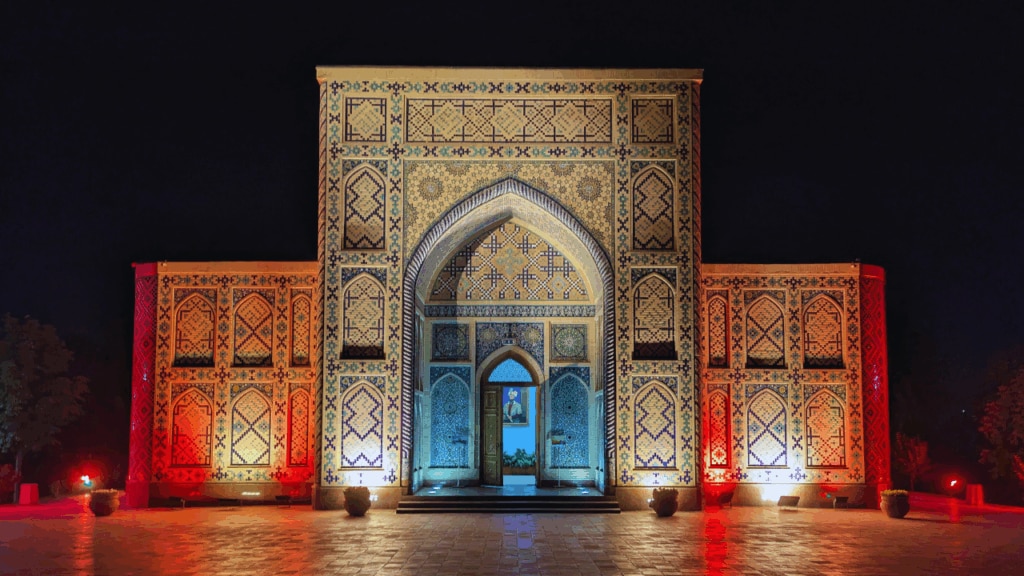
Ulugh Beg founded the Ulugh Beg Observatory and Madrasah in Samarkand, an important centre of astronomical study in Central Asia at the time. The two sites can still be visited today. “The observatory produced unequalled astronomical observations,” notes Stanford University.

In the capital Tashkent, the very first Quran is said to be preserved at the Hazrati Imam Complex. Recorded by UNESCO, this is said to be one of the six copies that Hazrat Uthmanra ordered to be formed into a book and standardised for the first time in Islamic history. He reportedly sent 5 of them across the Muslim world and kept this copy. It is said to still have traces of his blood as he was martyred in his home whilst reciting from this very book. If these claims are confirmed, it would perhaps be the greatest proof that the Quran at the time of the Holy Prophetsa and his Khulafa-e-Rashideen has been preserved to this day as foretold in the Holy Quran itself.
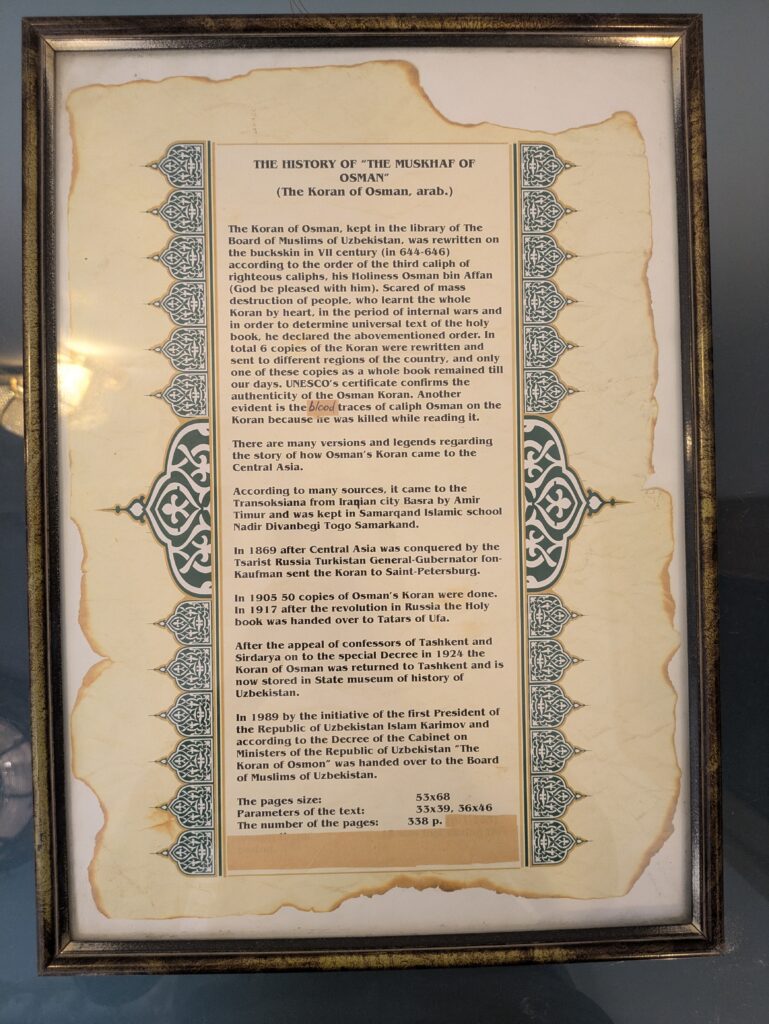
“Verily, it is We Who have sent down this Exhortation, and most surely We are its Guardian.” (Surah al-Hijr, Ch.15: V.10)
Samarkand is the place where a close companion of the Holy Prophetsa is buried. Hazrat Qutham ibn Abbasra was a cousin of the Prophetsa and the first Muslim missionary in the territory of modern-day Uzbekistan. His tomb is located inside the Shah-i-Zinda necropolis. Outside his tomb, it is written on a plaque that the Holy Prophetsa is reported to have said about him: “Qutham ibn Abbas is similar to me in looks and character more than any other person.”
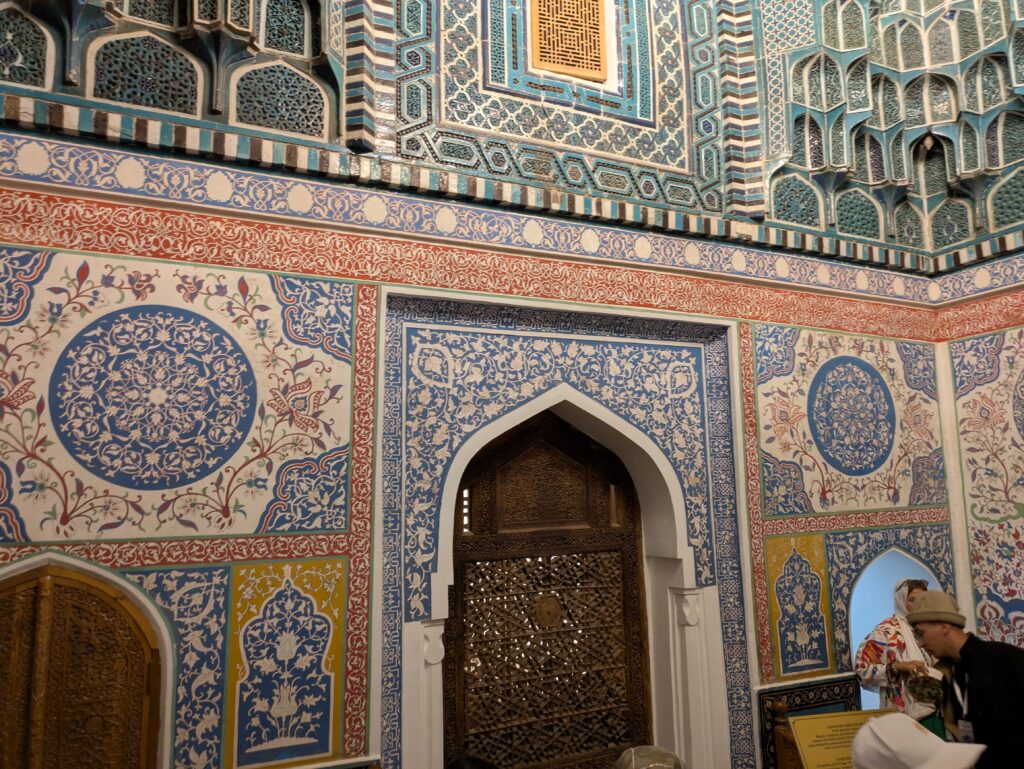
Visiting the graves of the pious and holy people of the past inspires one to follow in their footsteps and continue their legacy of godliness and spirituality.
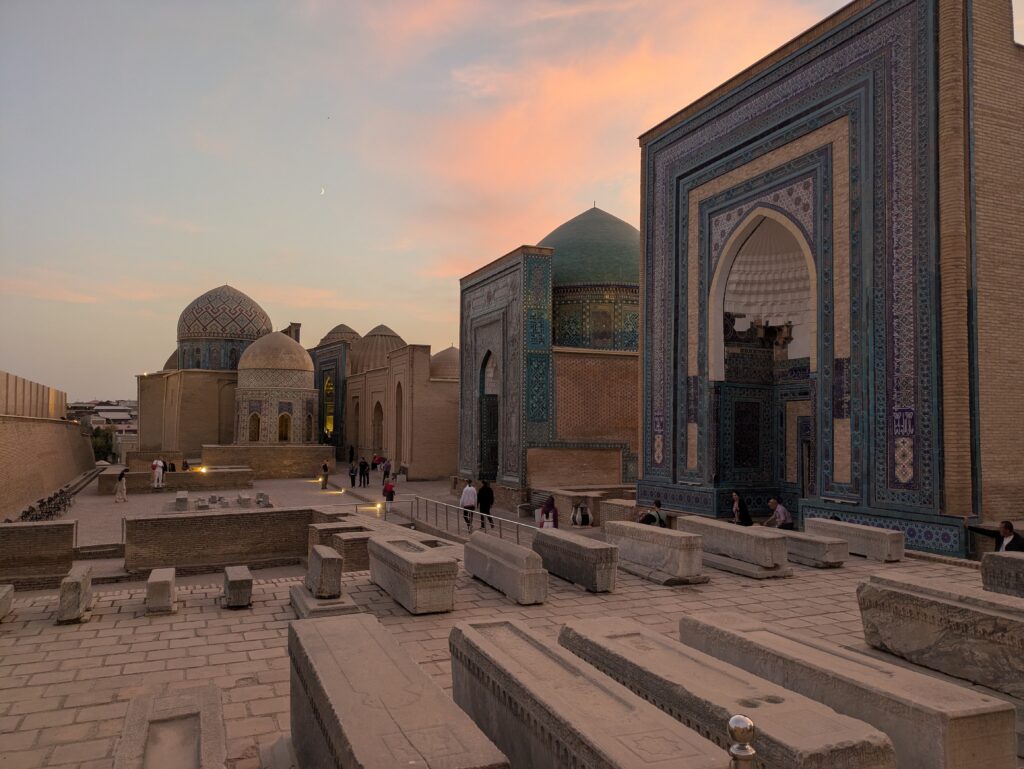
Indeed, the Holy Prophetsa instructed his followers to visit graveyards often, as it reminds one of the Hereafter. The Promised Messiahas would visit the graves of the pious and saintly people and stated that the soul has a connection to its grave. It is difficult to describe the atmosphere when you enter the room of Hazrat Qutham ibn Abbas’ tomb. Many people climb the many steps to visit it and pray there. One recalls the sacrifices the companions made in the cause of Islam and in the support of the Holy Prophetsa when Islam was at its most vulnerable state; this kindles the urge to pray for them fervently.
Enduring Islamic inspiration
The Madrassa complex in Registan Square, Samarkand, is a sight to behold. Grand gates with profound Quranic quotes await each visitor.
Beautifully written on top of one of the walls of the Madrassa is the inspiring Quranic verse:
“He grants wisdom to whom He pleases, and whoever is granted wisdom has indeed been granted abundant good” (Surah al-Baqarah, Ch.2: V.270). Needless to say, the education centres of the time were built in such a way as to inspire awe and passion for the pursuit of knowledge and learning.
On top of another small door is written the Hadith: “The scholars of my Ummah are like the Prophets of Bani Israel.”

The land of Uzbekistan has been home to numerous Islamic scholars, saints, and sages throughout history; the impact of their teachings and examples has endured. The hospitality of the Uzbeki people is second to none. They smile, greet you with assalamu alaikum and ask where you are from. In the hotels, there isn’t just professionalism, there is genuine kindness and eagerness to assist you.
The Hijab is worn by most women, and while Mosques aren’t always quite full, there are always people praying there. The spirit of Islam seems to have been sustained in the country despite centuries of communist rule. Many a time, taxi drivers or waiters in restaurants would be shocked at getting a tip, rather than expecting it like other Muslim countries I have visited. They would return extra money even though they could have easily pocketed it without me knowing. Of course, tourist traps exist everywhere, but this was my overall impression.
Hazrat Imam Bukharirh
Bukhara is the birthplace of Hazrat Imam Bukharirh, author of the most authentic and authoritative book after the Holy Quran, known as Sahih al-Bukhari. This book of Hadith, or narrations of the Holy Prophetsa, holds about 4,000 Hadith, more than 7,000 if you include repetitions from different sources. At the age of 16, he travelled to Mecca for Hajj with his mother and stayed behind to seek knowledge. He narrowed down 600,000 narrations, which he collected and memorised over the course of 16 years of meticulous research and investigation.

Before writing down any Hadith, he would offer two rakat of nafl prayer and do istikhara. Only then would he record it in his final compilation. He travelled the length and breadth of the Islamic world, including present-day Syria, Iraq, Iran, Yemen and Egypt, to not just collect each narration, but to meticulously verify them through a chain of trustworthy narrators. His principle was that to avoid misinterpretations of Hadith, he would include a relevant Quranic verse at the head of the chapter. (Sahih al-Bukhari, Vol. 1, Islam International Publications, 2025) This is the approach which the Promised Messiahas has also taught – that the ahadith are subservient to the Holy Quran and not the other way around, as some Muslims believe. He spent his last 24 years teaching the ahadith he had collected.
When he returned to Bukhara after his travels, the governor demanded that he only teach his children the Ahadith. However, Imam Bukhari replied that such knowledge should be public, and he could not restrict his teaching to the ruler’s family. Due to this and other factors, Imam Bukhari left his hometown and settled in Samarkand in exile, where he is buried today.
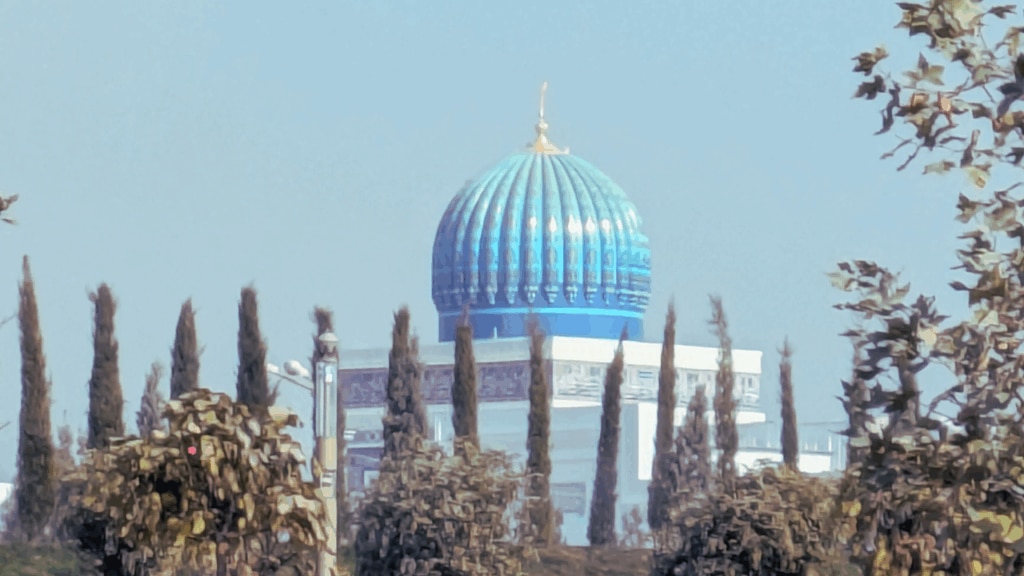
His tomb lies in the Imam Bukhari Mausoleum to the north of Samarkand. In 1998, it was restored after centuries of neglect and disrepair. The complex now consists of his tomb, a beautiful mosque, and a library. It is undergoing intense renovation works and, as of November 2025, remains closed to the public, but one can view it and pray from afar. Again, visiting the tomb of such a great figure of Islamic history generates love for them and the Holy Prophet Muhammadsa and instils a sense of honour and pride for Islam. In a time when many Muslims themselves look to Islam with disdain and reject its teachings, visiting such sites is necessary to learn one’s history and reclaim one’s heritage.
Lessons from the ruins of empires
Walking in the Old City of Bukhara feels as though you have stepped into the past. The hustle and bustle of markets, the debates and discussions at renowned Madrassas and the call to prayer at the beautified mosques. All that remains today, though, is mere walls and relics.
Seeing the ruins of once great empires puts everything into perspective. You remember your own mortality. You’re immediately humbled, and while there is sadness that once-great empires, centres of learning, and international trade routes are now relics of the past and only ruins, they hold out vital lessons for us as we work to rebuild a world fractured by division, greed, and inequality.
This is why the Holy Quran tells us to “travel in the earth” so that we may gain perspective and witness that all mighty empires that thought they were the heart of civilisation and greatness, had their downfalls when they committed inequities and rejected the Messengers of God.
The Holy Quran states: “Have they not travelled in the earth that they could see what was the end of those before them? They were mightier than these in the power that they wielded and more skilled as witnessed by the remains that they have left in the earth; but Allah seized them with ruin because of their sins, and there was none who could shield them against Allah’s wrath.” (Surah al-Mu‘min, Ch.40: V.22)
Whether it was the Byzantine Empire, the Roman Empire, the British Empire, the Soviet Union, or indeed the Islamic Empire, little remains except ruins and relics in museums. When inequities dominated the affairs of such nations and they became unjust, their downfall soon followed.
It’s almost as if Allah was speaking to the nations of today, reminding them that you may think you are the most powerful and advanced civilisation in history, yet many empires before you were more powerful, wealthier, vast and advanced than you. However, all had their downfall and became tales of the past, serving as lessons from which to derive.
The Quran states: “Do you build monuments on every high place seeking vain glory?” (Surah ash-Shu‘ara, Ch.26: V.129)
The Burj Khalifa in Dubai is the tallest freestanding tower ever built. There is a race to construct the tallest building in the world, with the current one standing at 828 metres. In response, Saudi Arabia is rushing to build the “Jeddah Tower” at a height of 1km by 2028.
It is a word-by-word fulfilment of the Hadith that one of the signs of the hour of the final days would be, “When you see the barefoot, naked, destitute shepherds competing in constructing tall buildings.” (Sunan Ibn Majah, Kitab al-Muqaddimah, Hadith 63). At the time of this Hadith, people of these nations were indeed simple shepherds; now they compete in building the tallest towers in the world.
Rather than competing in intellectual pursuits, scientific advancements, and theological discussions and following the paths of their forefathers, they are content with building lavish mosques and tall skyscrapers.
The Holy Prophetsa foretold of this: “There will come a time upon the people when nothing will remain of Islam except its name only and nothing will remain of the Quran except its inscription. Their mosques will be splendidly furnished but destitute of guidance. Their divines will be the worst people under the heaven and strife will issue from and avert to them.” (Mishkatul Masabih, Hadith 276)
At that time, as the Hadith literature and Quranic verses foretell, Allah would raise the Messiah and his Jamaat in the Latter Days, who would walk alongside the companions of the Holy Prophetsa, revive the spirit of love and sacrifice and restore Islam’s honour. When you visit these sites in Uzbekistan, you realise the prominence the earlier Muslims reached and the heights expected of those who have come after them.
To see those who attribute themselves to the Holy Prophetsa regress should pain every Muslim. The Promised Messiahas had such pain that Allah revealed the following prayer to him: “Lord, reform the people of Muhammadsa.” (Tadhkirah [English], 2009, UK, Revelation of 1882)
At a time when Islamic political power is at its lowest point in history, when Islamophobia is soaring and ignorance about Islam is widespread, seeing the historical centres of Bukhara and Samarkand puts the work of restoring Islam’s lost heritage into perspective.
Whilst the Islamic Golden Age has ended and nothing remains but the memories and ruins of those great scholars and centres of learning, now is a time for a new Golden Era of Islam.

